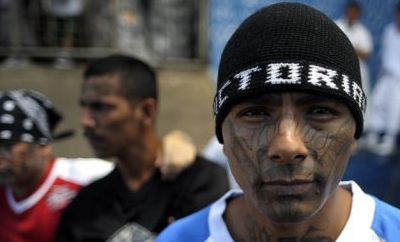El Salvador and Honduras are pioneering new efforts to stop gang-related violence via truces, but there are some critical differences between the two experiments that may make or break them.
Local governments, the international community, and the Catholic Church have played key roles in fostering the efforts to forge the truces, which have had the greatest single impact on violence in the region since the end of the civil wars in Central America and the negotiated settlement with paramilitaries in Colombia.
While the Honduran pact is still in its infancy, the El Salvador gang truce has halved homicides in that nation, once touted as one of the most violent in the world. There is a similar hope in Honduras.
However, while the gangs’ names are the same and the type of violence that they perpetrate is similar, there are several key distinctions that may determine whether the truces are a success or a failure, and their results replicated elsewhere.
1) The dominant gang. The Barrio 18 has greater numbers and reach in Honduras, whereas the MS-13 is the dominant gang in El Salvador. The difference is important because the Barrio 18 is divided and less disciplined than their MS-13 counterparts. The Barrio 18 has Sureños and Revolucionarios wings in El Salvador, and while they ostensibly have a solid base in Honduras, the gang is more fractured there. The ability of El Salvador’s MS-13 leaders to keep middle and low-level gang members on the same page has been a surprising and critical part of the gang truce’s success in that country. But achieving the same level of success in Honduras may prove elusive.
2) Gang makeup. The gang leadership in El Salvador has more political experience than their counterparts in Honduras. Some of the Salvadorans are former guerrillas; others have been in regional leadership roles for years, as the nominal headquarters of these gangs is El Salvador. The result is a more seasoned, experienced team of negotiators who understand what is at stake and how best to take advantage of this path towards legitimacy. By the same token, it could be argued they also understand how to game the system and develop more sophisticated criminal structures.
SEE ALSO: 5 Things the El Salvador Gang Truce has Taught Us
3) History. For at least a decade, gang leaders in El Salvador have been in conversations with the government, non-governmental organizations, and religious figures in an attempt to alter their situation. These conversations have shaped their understanding of what is and what is not possible. These dialogues have also put gang leaders in close contact with key stakeholders who can help them assess their political weight going forward. A gang truce will only work if the participants understand the context in which they are forging this agreement and with whom. In El Salvador, there is a far greater understanding of that context than in Honduras.
4) Government credibility. In both countries, the government has taken a back seat to Catholic Church representatives and other civilian and international mediators. However, the El Salvador government has far more credibility, as well as some reliable interlocutors and institutions through which it can initiate the next phase of the process, which should include social, educational and vocational training for poor communities where gangs prosper. Honduras, in contrast, is facing an institutional crisis of historic proportions. Since the 2009 coup that sent President Manuel Zelaya into exile, the country has entered into a terrible political spiral in which few politicians have the credibility to rally public support around anything, much less a controversial gang truce. On the whole, Honduras’ government lacks the credibility needed to garner the necessary funds from the international community, in order to implement new social programs and steer the gang issue in a different direction.
SEE ALSO: 5 Questions About Honduras Gang Pact
5) Mediators. The one area where Honduras may have an advantage is on the mediation front. The Honduras gang truce meetings — which are just meetings and not technically a truce yet — are being managed by a high level Catholic Church official, the auxiliar Bishop Romulo Emiliani of San Pedro Sula, giving the sense of a united front on the Church’s part. In contrast, the Salvadoran process is being mediated, in part, by a divided Catholic Church via the military chaplain, Bishop Fabio Colindres. While Emiliani has not had public differences with the hierarchy in his country, the Catholic Conference of Bishops in El Salvador has emitted public expressions of concern that the truce has “not produced any benefits for the honorable and hard-working population.”
In reality, both truces carry with them challenges and opportunities. But to take advantage of the opportunities, the governments, the mediators, and the gang leaders are going to have to understand and overcome some of the challenges described above.

